Nib-Assisted Coaxial Electrohydrodynamic Jet Printing for Nanowires Deposition
Abstract
1. Introduction
2. Printing Approach
3. Materials and Simulation Methods
3.1. Materials
3.2. Preparation of Materials and Substrate
3.3. Characterization
3.4. Simulation Model
4. Results and Discussion
4.1. Velocity Field and Voltage Influence on the Coaxial Cone Jets Using Assisted-Nib and Normal Needle
4.2. Space Charge Density of the Coaxial Cone Jets
5. Experiments of Nib-Assisted Enhancement Electric Field Intensity and Cone Jet Stability
5.1. Experimentation of Particle Tracking Jet Reflux
5.2. Printing Results and Characterization
Flexible Nanowires Deposition
6. Conclusions
Author Contributions
Funding
Institutional Review Board Statement
Informed Consent Statement
Data Availability Statement
Conflicts of Interest
References
- Kim, K.; Oh, S.M.; Hong, J.; Jung, C.; Seo, J.; Jeong, Y.J.; Lee, H.S.; Kim, S.H. Electrohydrodynamic Jet Printing of Small-Molecule Semiconductor Crystals on Chemically Patterned Surface for High-Performance Organic Field-Effect Transistors. Mater. Chem. Phys. 2022, 285, 126165. [Google Scholar] [CrossRef]
- Wang, Y.; Zhou, J.; Li, J. Construction of Plasmonic Nano-Biosensor-Based Devices for Point-of-Care Testing. Small Methods 2017, 1. [Google Scholar] [CrossRef]
- Maiullari, F.; Costantini, M.; Milan, M.; Pace, V.; Chirivì, M.; Maiullari, S.; Rainer, A.; Baci, D.; Marei, H.E.S.; Seliktar, D.; et al. A Multi-Cellular 3D Bioprinting Approach for Vascularized Heart Tissue Engineering Based on HUVECs and IPSC-Derived Cardiomyocytes. Sci. Rep. 2018, 8, 1–15. [Google Scholar] [CrossRef]
- Cidonio, G.; Glinka, M.; Dawson, J.I.; Oreffo, R.O.C. Improving Biofabrication by Printing Stem Cells for Skeletal Regenerative MedicineThe Cell in the Ink. Biomaterials 2019, 209, 10–24. [Google Scholar] [CrossRef]
- Janissen, R.; Sahoo, P.K.; Santos, C.A.; Da Silva, A.M.; Von Zuben, A.A.G.; Souto, D.E.P.; Costa, A.D.T.; Celedon, P.; Zanchin, N.I.T.; Almeida, D.B.; et al. InP Nanowire Biosensor with Tailored Biofunctionalization: Ultrasensitive and Highly Selective Disease Biomarker Detection. Nano Lett. 2017, 17, 5938–5949. [Google Scholar] [CrossRef] [PubMed]
- Keum, H.; Mccormick, M.; Liu, P.; Zhang, Y.; Omenetto, F.G. RESEARCH ARTICLES Epidermal Electronics. Science 2011, 333, 838–843. [Google Scholar] [CrossRef]
- Sang, S.; Pei, Z.; Zhang, F.; Ji, C.; Li, Q.; Ji, J.; Yang, K.; Zhang, Q. Three-Dimensional Printed Bimodal Electronic Skin with High Resolution and Breathability for Hair Growth. ACS Appl. Mater. Interfaces 2022, 14, 31493–31501. [Google Scholar] [CrossRef] [PubMed]
- Liu, C.; Huang, N.; Xu, F.; Tong, J.; Chen, Z.; Gui, X.; Fu, Y.; Lao, C. 3D Printing Technologies for Flexible Tactile Sensors toward Wearable Electronics and Electronic Skin. Polymers 2018, 10, 629. [Google Scholar] [CrossRef]
- Ooka, Y.; Tetsumoto, T.; Fushimi, A.; Yoshiki, W.; Tanabe, T. CMOS Compatible High-Q Photonic Crystal Nanocavity Fabricated with Photolithography on Silicon Photonic Platform. Sci. Rep. 2015, 5, 1–9. [Google Scholar] [CrossRef] [PubMed]
- Luo, C.; Xu, C.; Lv, L.; Li, H.; Huang, X.; Liu, W. Review of Recent Advances in Inorganic Photoresists. RSC Adv. 2020, 10, 8385–8395. [Google Scholar] [CrossRef]
- Hwang, S.H.; Zhao, Z.J.; Jeon, S.; Kang, H.; Ahn, J.; Jeong, J.H. Repeatable and Metal-Independent Nanotransfer Printing Based on Metal Oxidation for Plasmonic Color Filters. Nanoscale 2019, 11, 11128–11137. [Google Scholar] [CrossRef]
- Zhou, H.; Qin, W.; Yu, Q.; Cheng, H.; Yu, X.; Wu, H. Transfer Printing and Its Applications in Flexible Electronic Devices. Nanomaterials 2019, 9, 283. [Google Scholar] [CrossRef] [PubMed]
- Garra, J.; Long, T.; Currie, J.; Schneider, T.; White, R.; Paranjape, M. Dry etching of polydimethylsiloxane for microfluidic systems. J. Vac. Sci. Technol. A Vac. Surf. Film. 2002, 20, 975–982. [Google Scholar] [CrossRef]
- Kolodziej, C.M.; Maynard, H.D. Electron-Beam Lithography for Patterning Biomolecules at the Micron and Nanometer Scale. Chem. Mater. 2012, 24, 774–780. [Google Scholar] [CrossRef]
- Liang, X.; Shu, L.; Lin, H.; Fang, M.; Zhang, H.; Dong, G.; Yip, S.; Xiu, F.; Ho, J.C. Inverted Silicon Nanopencil Array Solar Cells with Enhanced Contact Structures. Sci. Rep. 2016, 6, 1–8. [Google Scholar] [CrossRef]
- Lee, Y. Direct Printing and Electrical Characterization of Conductive Micro-Silver Tracks by Alternating Current-Pulse Modulated Electrohydrodynamic Jet Printing. J. Manuf. Sci. Eng. 2017, 139, 1–10. [Google Scholar] [CrossRef]
- Zeleny, J. The Electrical Discharge from Liquid Points, and a Hydrostatic Method of Measuring the Electric Intensity at Their Surfaces. Phys. Rev. 1914, 3, 69–91. [Google Scholar] [CrossRef]
- Rosenhead, L. Instability of Liquid Surfaces. Nature 1933, 131, 175–176. [Google Scholar] [CrossRef]
- Taylor, G.I. Disintegration of Water Drops in an Electric Field. Proc. R. Soc. London. Ser. A Math. Phys. Sci. 1964, 280, 383–397. [Google Scholar] [CrossRef]
- Hayati, I.; Bailey, A.I.; Tadros, T.F. Mechanism of Stable Jet Formation in Electrohydrodynamic Atomization. Nature 1986, 319, 41–43. [Google Scholar] [CrossRef]
- Tang, K.; Gomez, A. Generation by Electrospray of Monodisperse Water Droplets for Targeted Drug Delivery by Inhalation. J. Aerosol Sci. 1994, 25, 1237–1249. [Google Scholar] [CrossRef]
- Cloupeau, M.; Prunet-Foch, B. Electrostatic Spraying of Liquids in Cone-Jet Mode. J. Electrost. 1989, 22, 135–159. [Google Scholar] [CrossRef]
- Loscertales, I.G.; Barrero, A.; Guerrero, I.; Cortijo, R.; Marquez, M.; Gañán-Calvo, A.M. Micro/Nano Encapsulation via Electrified Coaxial Liquid Jets. Science 2002, 295, 1695–1698. [Google Scholar] [CrossRef] [PubMed]
- Sen, A.K.; Darabi, J.; Knapp, D.R. Analysis of Droplet Generation in Electrospray Using a Carbon Fiber Based Microfluidic Emitter. J. Fluids Eng. Trans. ASME 2011, 133, 4325. [Google Scholar] [CrossRef]
- Hartman, R.P.A.; Brunner, D.J.; Camelot, D.M.A.; Marijnissen, J.C.M.; Scarlett, B. Electrohydrodynamic Atomization in the Cone-Jet Mode Physical Modeling of the Liquid Cone and Jet. J. Aerosol Sci. 1999, 30, 823–849. [Google Scholar] [CrossRef]
- Lastow, O.; Balachandran, W. Numerical Simulation of Electrohydrodynamic (EHD) Atomization. J. Electrost. 2006, 64, 850–859. [Google Scholar] [CrossRef]
- Forbes, T.P.; Degertekin, F.L.; Fedorov, A.G. Electrohydrodynamics of Charge Separation in Droplet-Based Ion Sources with Time-Varying Electrical and Mechanical Actuation. J. Am. Soc. Mass Spectrom. 2010, 21, 501–510. [Google Scholar] [CrossRef] [PubMed]
- Lim, L.K.; Hua, J.; Wang, C.H.; Smith, K.A. Numerical Simulation of Cone-Jet Formation in Electrohydrodynamic Atomization. AIChE J. 2011, 57, 57–78. [Google Scholar] [CrossRef]
- Wu, X.; Oleschuk, R.D.; Cann, N.M. Characterization of Microstructured Fibre Emitters: In Pursuit of Improved Nano Electrospray Ionization Performance. Analyst 2012, 137, 4150–4161. [Google Scholar] [CrossRef]
- Hayati, I.; Bailey, A.; Tadros, T.F. Investigations into the Mechanism of Electrohydrodynamic Spraying of Liquids. II. Mechanism of Stable Jet Formation and Electrical Forces Acting on a Liquid Cone. J. Colloid Interface Sci. 1987, 117, 222–230. [Google Scholar] [CrossRef]
- Yan, F.; Farouk, B.; Ko, F. Numerical Modeling of an Electrostatically Driven Liquid Meniscus in the Cone-Jet Mode. J. Aerosol Sci. 2003, 34, 99–116. [Google Scholar] [CrossRef]
- Herrada, M.A.; López-Herrera, J.M.; Gañán-Calvo, A.M.; Vega, E.J.; Montanero, J.M.; Popinet, S. Numerical Simulation of Electrospray in the Cone-Jet Mode. Phys. Rev. E Stat. Nonlinear Soft Matter Phys. 2012, 86, 026305. [Google Scholar] [CrossRef]
- Wei, W.; Gu, Z.; Wang, S.; Fukuda, T.; Kase, K.; Ju, J.; Yamagata, Y.; Tajima, Y. Numerical Simulation of Nanoparticle Pattern Fabricated by Electrostatic Spray Deposition. Particuology 2013, 11, 20–24. [Google Scholar] [CrossRef]
- Mohammadi, K.; Movahhedy, M.R.; Khodaygan, S. Colloidal Particle Reaction and Aggregation Control in the Electrohydrodynamic 3D Printing Technology. Int. J. Mech. Sci. 2021, 195, 106222. [Google Scholar] [CrossRef]
- Gupta, A.; Mishra, B.K.; Panigrahi, P.K. Internal and External Hydrodynamics of Taylor Cone under Constant and Alternating Voltage Actuation. Phys. Fluids 2021, 33, 71921. [Google Scholar] [CrossRef]
- Pandey, S.K.; James, A.R.; Raman, R.; Chatterjee, S.N.; Goyal, A.; Prakash, C.; Goel, T.C. Structural, Ferroelectric and Optical Properties of PZT Thin Films. Phys. B Condens. Matter 2005, 369, 135–142. [Google Scholar] [CrossRef]
- Xu, S.; Shi, Y. Power Generation from Piezoelectric Lead Zirconate Titanate Nanotubes. J. Phys. D: Appl. Phys. 2009, 42, 85301. [Google Scholar] [CrossRef]
- Guo, R.; Cross, L.E.; Park, S.E.; Noheda, B.; Cox, D.E.; Shirane, G. Origin of the High Piezoelectric Response in PbZr1-XTixO3. Phys. Rev. Lett. 2000, 84, 5423–5426. [Google Scholar] [CrossRef]
- Chen, X.; Xu, S.; Yao, N.; Shi, Y. 1.6 v Nanogenerator for Mechanical Energy Harvesting Using PZT Nanofibers. Nano Lett. 2010, 10, 2133–2137. [Google Scholar] [CrossRef]
- Nguyen, T.D.; Deshmukh, N.; Nagarah, J.M.; Kramer, T.; Purohit, P.K.; Berry, M.J.; McAlpine, M.C. Piezoelectric Nanoribbons for Monitoring Cellular Deformations. Nat. Nanotechnol. 2012, 7, 587–593. [Google Scholar] [CrossRef]
- Chen, X.; Xu, S.; Yao, N.; Xu, W.; Shi, Y. Potential Measurement from a Single Lead Ziroconate Titanate Nanofiber Using a Nanomanipulator. Appl. Phys. Lett. 2009, 94, 253113. [Google Scholar] [CrossRef]
- Barrero, A.; Gañán-Calvo, A.M.; Dávila, J.; Palacio, A.; Gómez-González, E. Low and High Reynolds Number Flows inside Taylor Cones. Phys. Rev. E Stat. Phys. Plasmas Fluids Relat. Interdiscip. Top. 1998, 58, 7309–7314. [Google Scholar] [CrossRef]
- Tan, Z. Partial Reflection of Hyaluronan Molecules Inside the Taylor-Cone During Electrospray. Engineering 2012, 4, 84–87. [Google Scholar] [CrossRef]
- Hamdi, M.; Havet, M.; Rouaud, O.; Tarlet, D. Comparison of Different Tracers for PIV Measurements in EHD Airflow. Exp. Fluids 2014, 55, 1–12. [Google Scholar] [CrossRef]
- Gouriou, C.; Traoré, P.; Louste, C. Influence of Seeding Particle Type on Velocity Measurements in Silicone Oil Under High Voltage. IEEE Trans. Ind. Appl. 2017, 53, 2471–2476. [Google Scholar] [CrossRef]
- Xie, S.; Ma, F.; Liu, Y.; Li, J. Multiferroic CoFe2O4-Pb(Zr0.52Ti 0.48)O3 Core-Shell Nanofibers and Their Magnetoelectric Coupling. Nanoscale 2011, 3, 3152–3158. [Google Scholar] [CrossRef]
- Wang, D.; Rocks, S.A.; Dorey, R.A. Electrohydrodynamic Atomization Deposition of PZT Sol-Gel Slurry and Sol Infiltration on the Films. J. Eur. Ceram. Soc. 2012, 32, 1651–1658. [Google Scholar] [CrossRef]
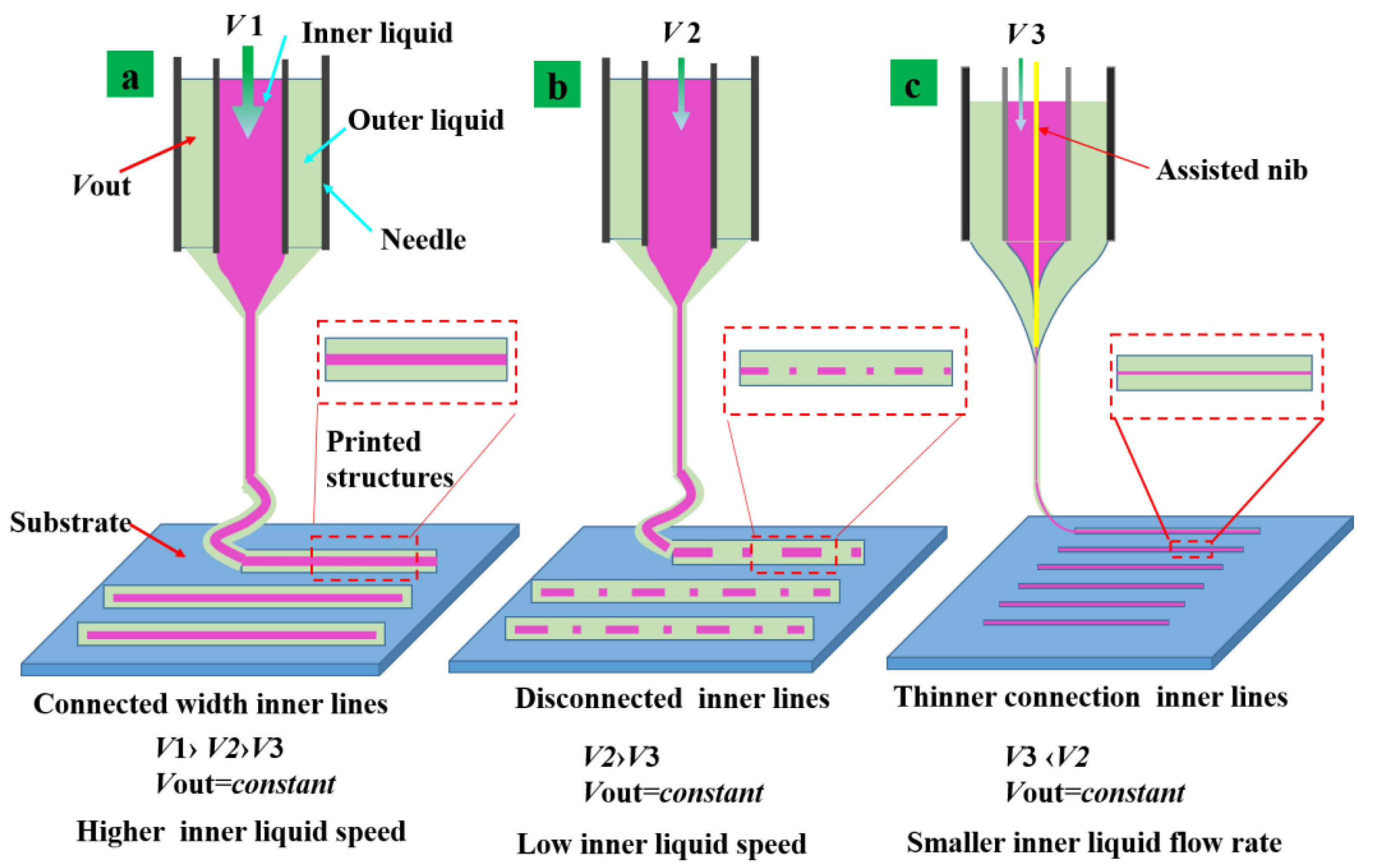
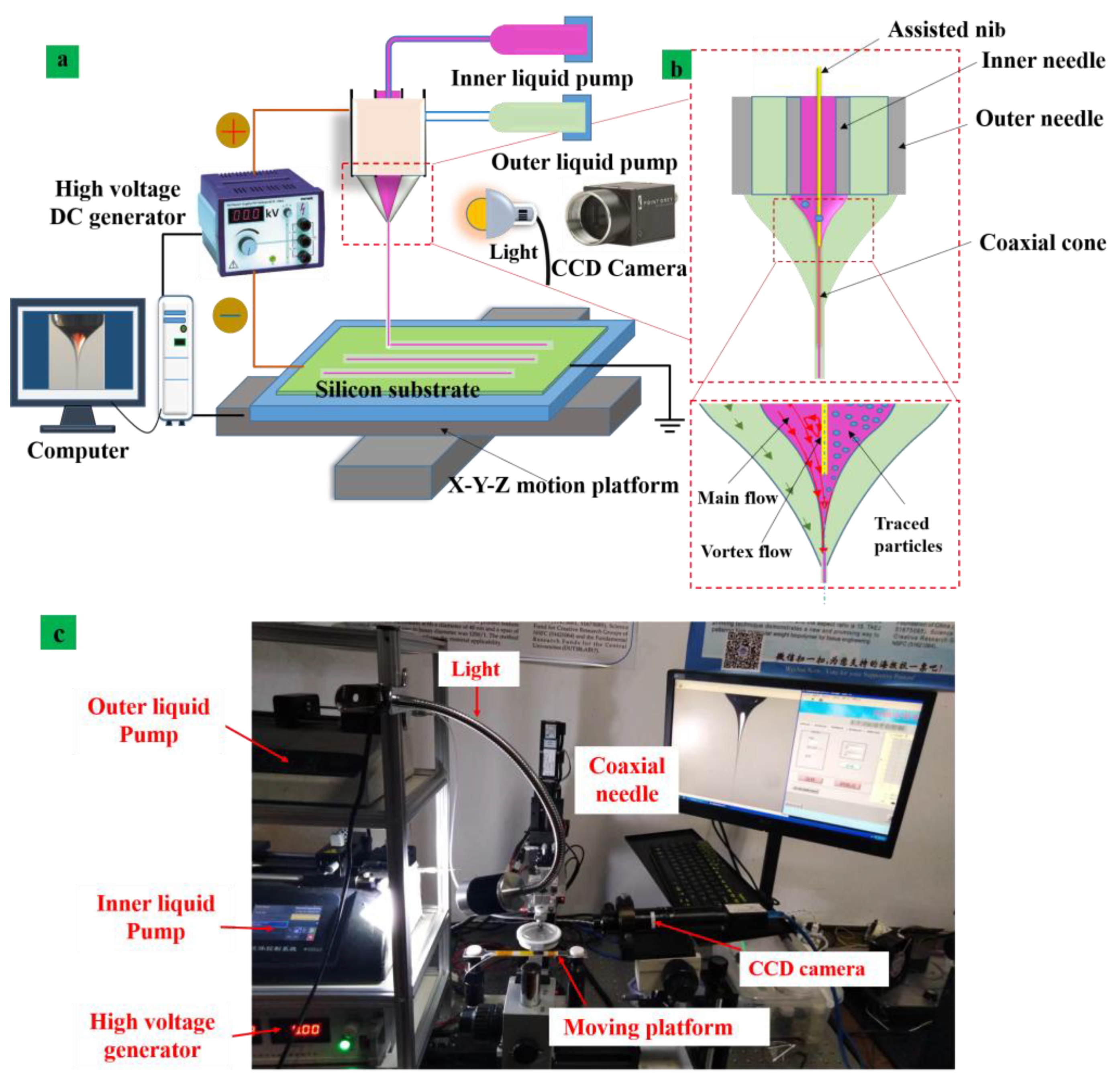
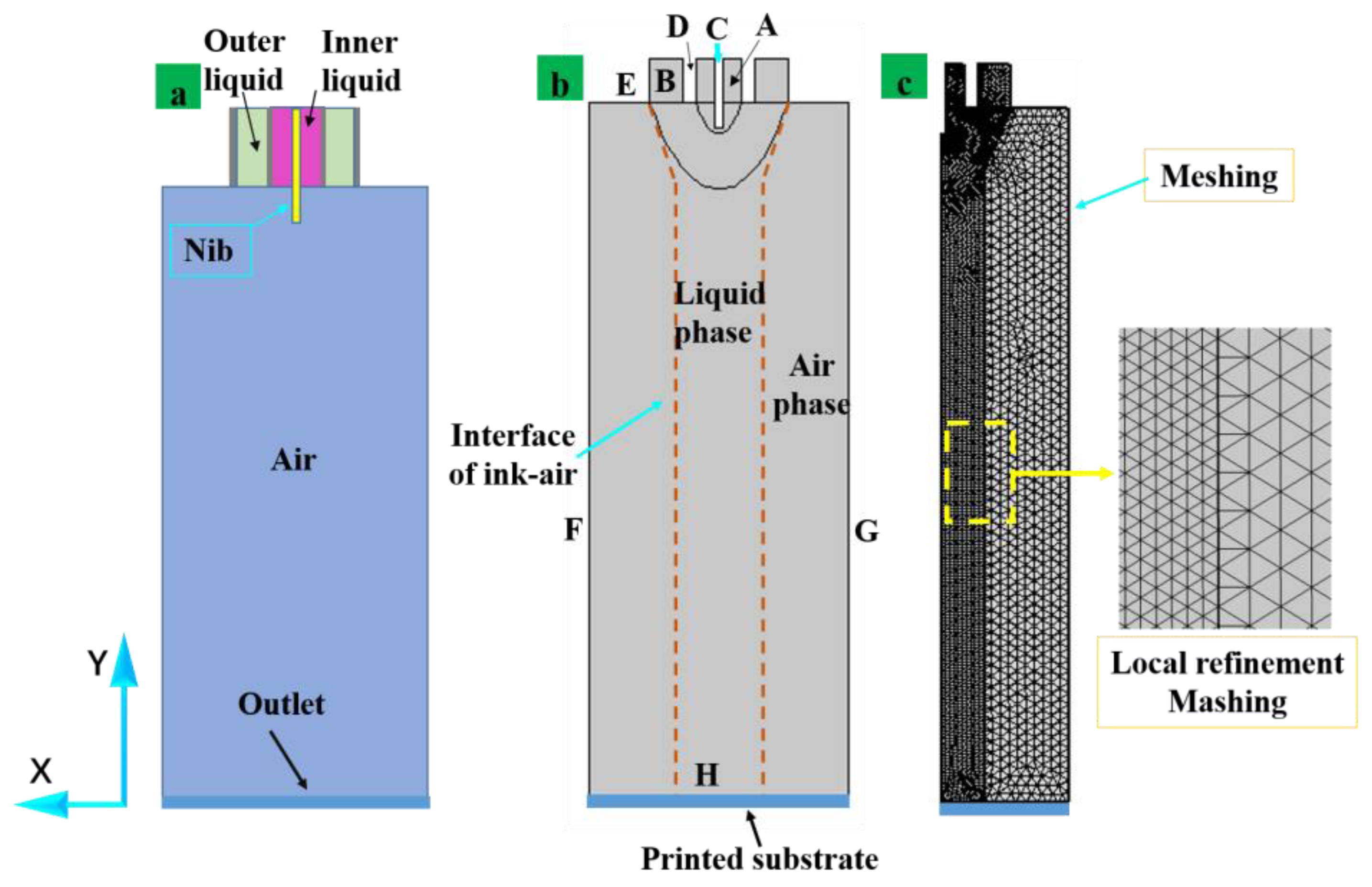
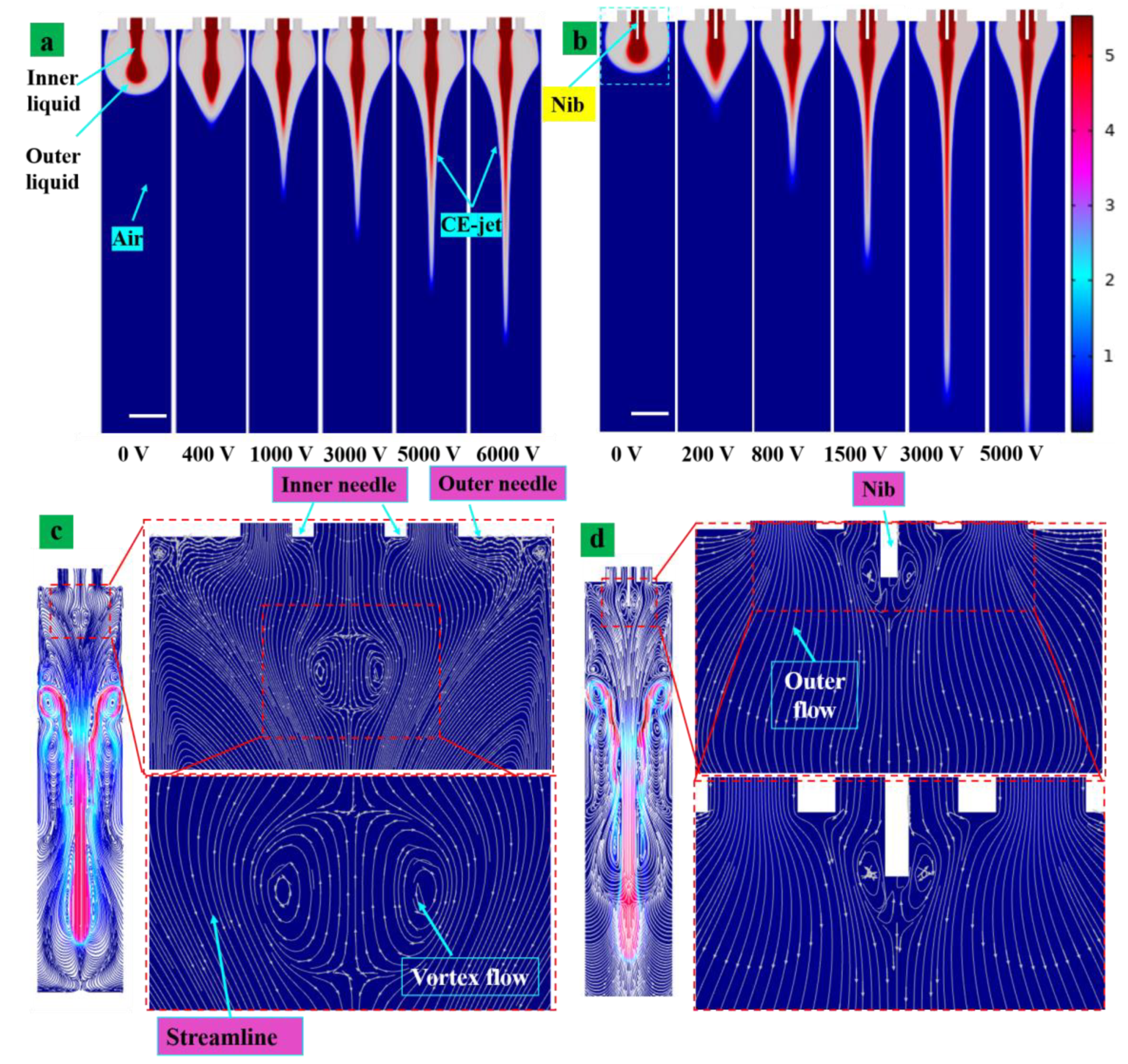

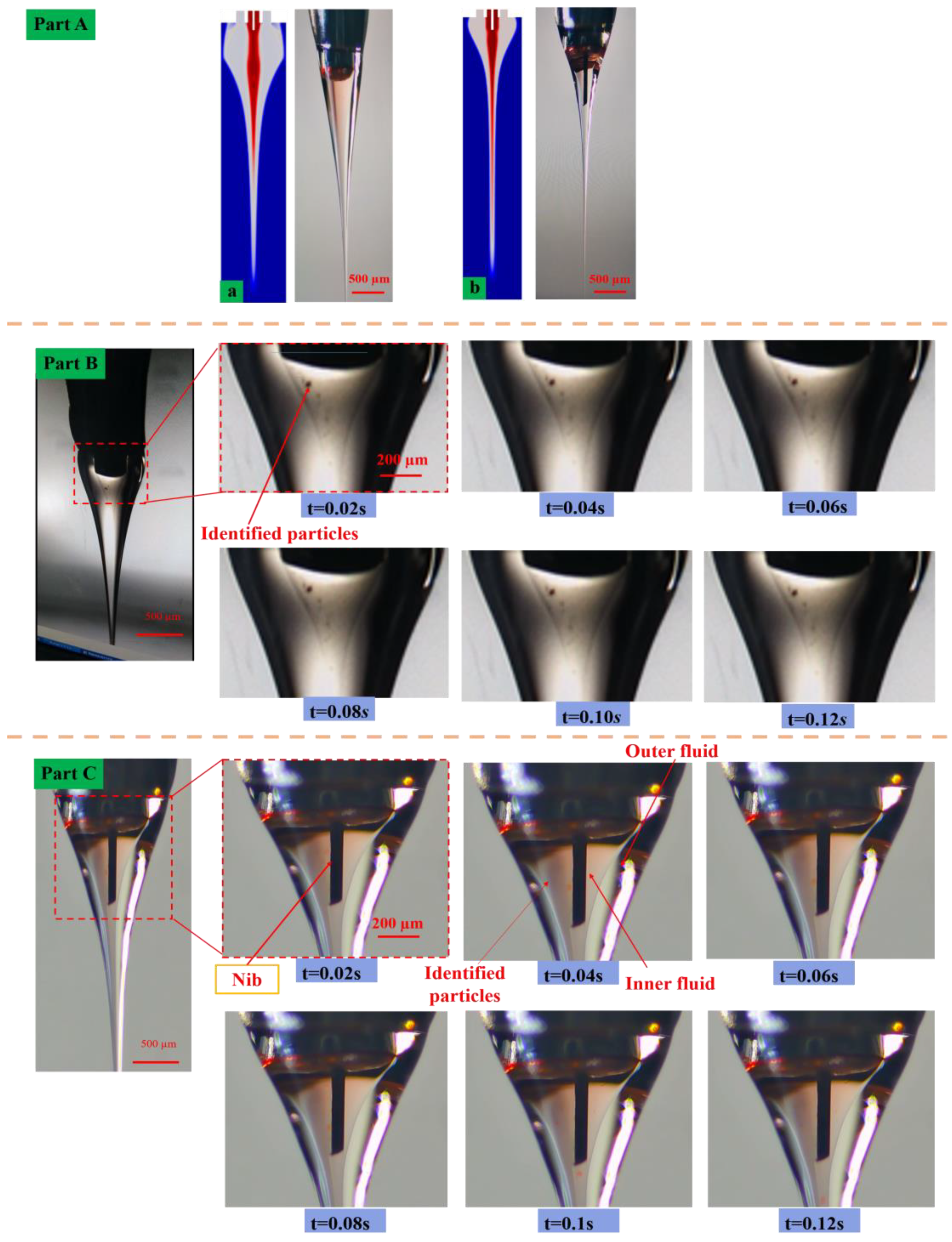
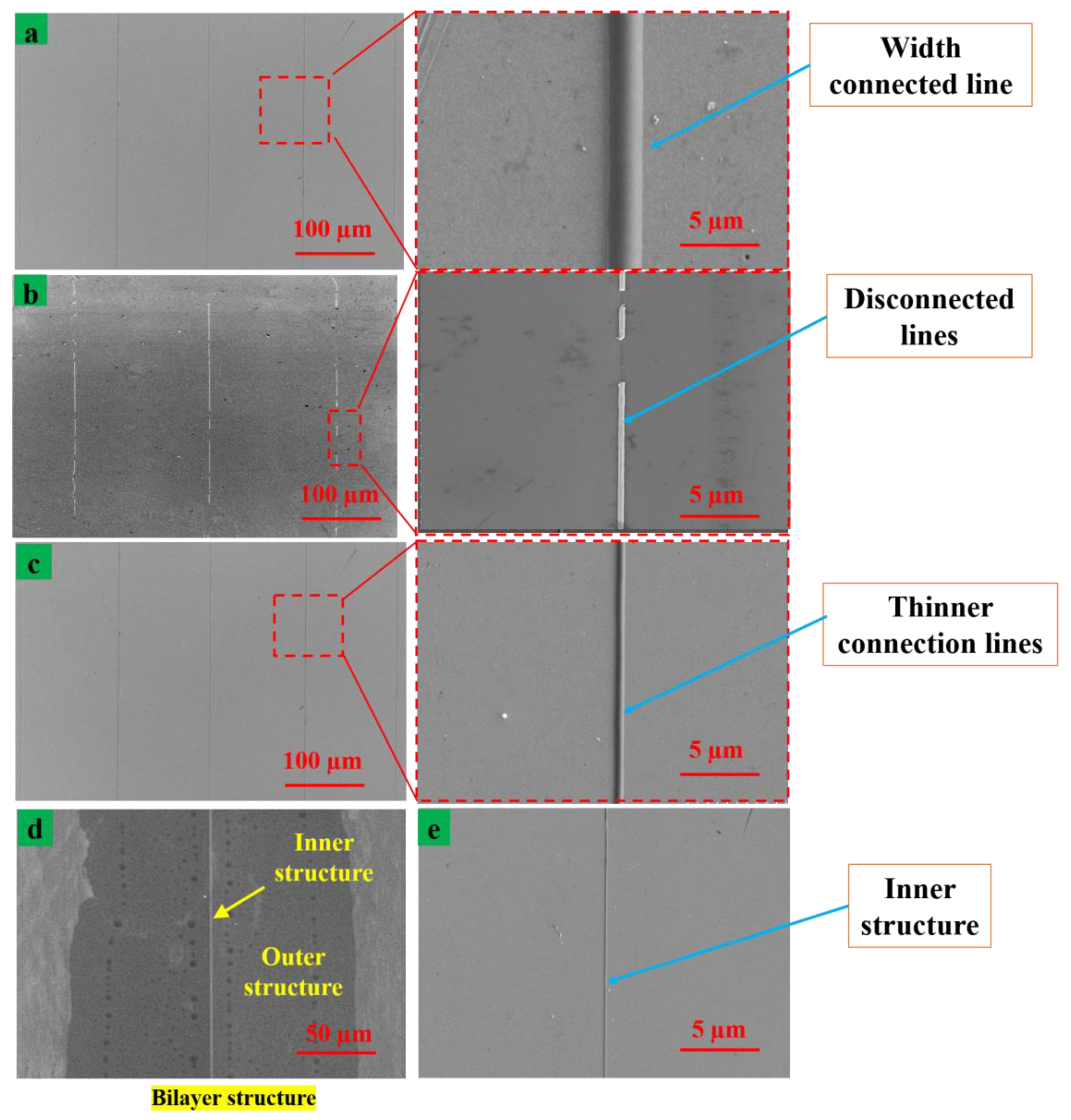
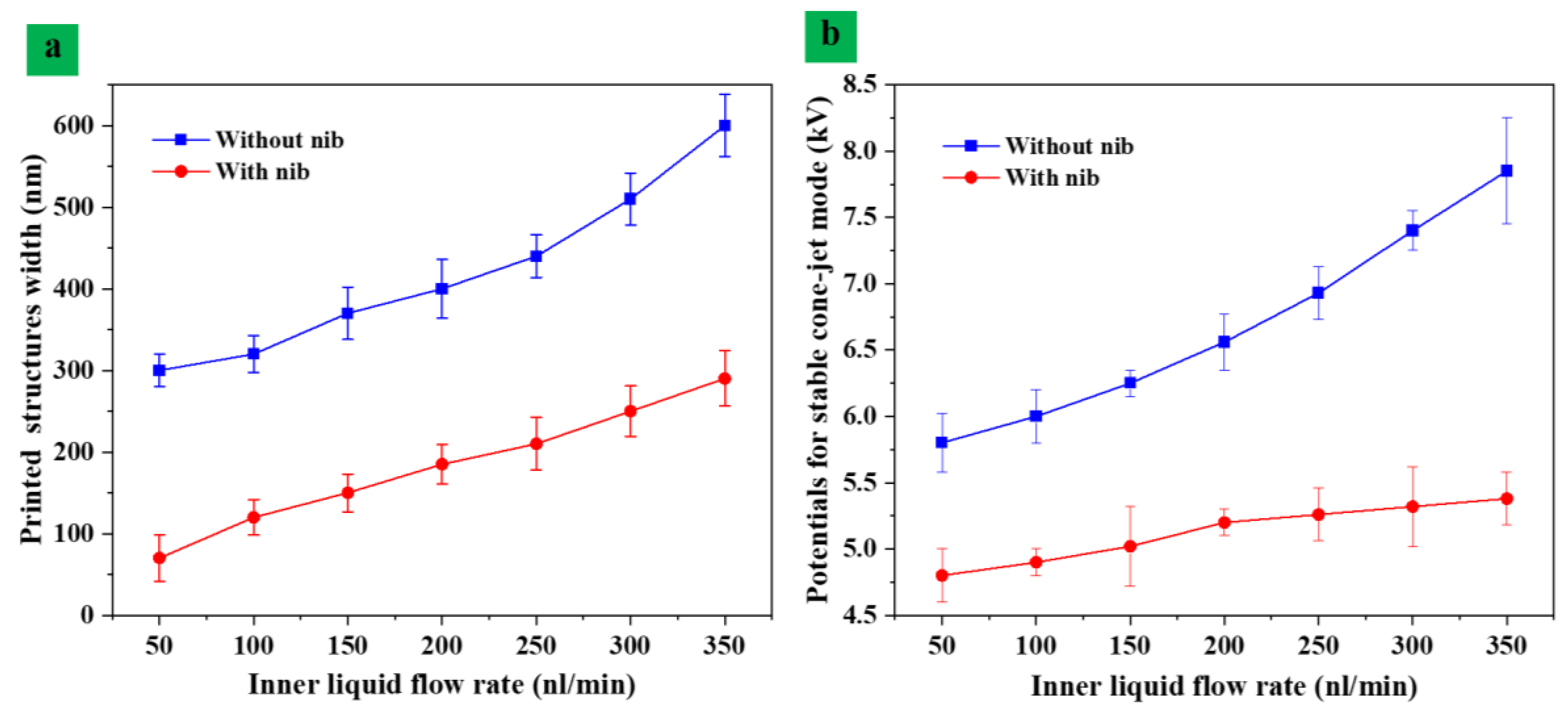
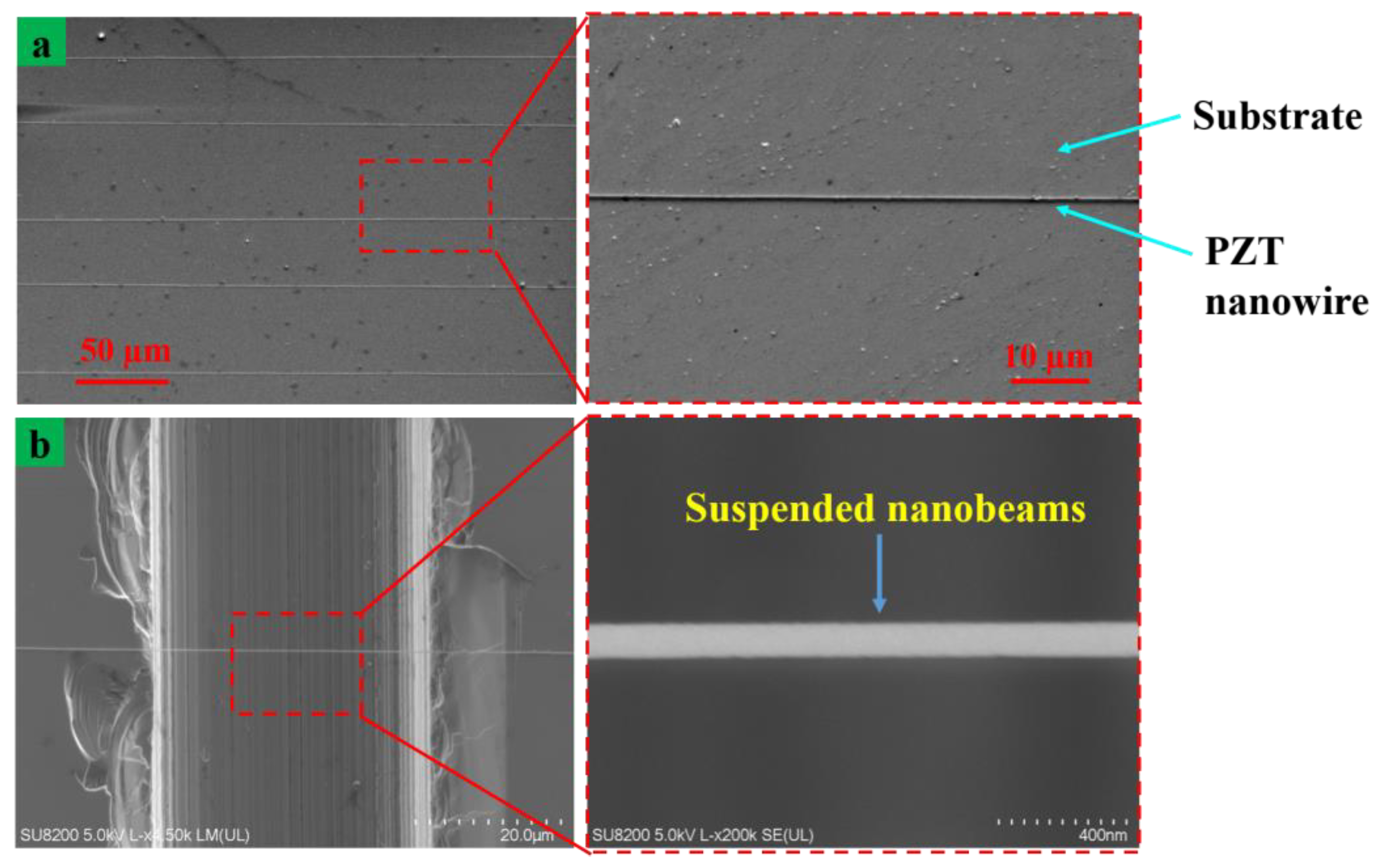

| Properties Values | Inner (PZT Sol) | Outer (Silicone Oil) |
|---|---|---|
| Viscosity | 160 mPa·s | 58.56 Pa·s |
| Specific gravity | 1016 kg m−3 | 976 kg m−3 |
| Surface tension | 0.0193 N/m | 0.022 N/m |
| Dielectric constant | 22 | 2.7 |
| Boundary | Electrostatic Field | Hydrodynamic Field |
|---|---|---|
| A: Inner needle inlet | E = V0 | Ui = Qi/Ai |
| B: Outer needle inlet | E = V0 | Uo = Qo/Ao |
| C: Wall of auxiliary needle | E = V0 | U = 0 |
| D: Wall of inner needle | E = V0 | U = 0 |
| E: Wall of outer needle | E = V0 | U = 0 |
| F: Boundary of computational domain | E = V | U = 0 |
| G: Boundary of computational domain | E = V0 | P = 0 |
| H: Outlet of needle system | 0 | P = 0 |
Disclaimer/Publisher’s Note: The statements, opinions and data contained in all publications are solely those of the individual author(s) and contributor(s) and not of MDPI and/or the editor(s). MDPI and/or the editor(s) disclaim responsibility for any injury to people or property resulting from any ideas, methods, instructions or products referred to in the content. |
© 2023 by the authors. Licensee MDPI, Basel, Switzerland. This article is an open access article distributed under the terms and conditions of the Creative Commons Attribution (CC BY) license (https://creativecommons.org/licenses/by/4.0/).
Share and Cite
Shi, S.; Abbas, Z.; Zhao, X.; Liang, J.; Wang, D. Nib-Assisted Coaxial Electrohydrodynamic Jet Printing for Nanowires Deposition. Nanomaterials 2023, 13, 1457. https://doi.org/10.3390/nano13091457
Shi S, Abbas Z, Zhao X, Liang J, Wang D. Nib-Assisted Coaxial Electrohydrodynamic Jet Printing for Nanowires Deposition. Nanomaterials. 2023; 13(9):1457. https://doi.org/10.3390/nano13091457
Chicago/Turabian StyleShi, Shiwei, Zeshan Abbas, Xiangyu Zhao, Junsheng Liang, and Dazhi Wang. 2023. "Nib-Assisted Coaxial Electrohydrodynamic Jet Printing for Nanowires Deposition" Nanomaterials 13, no. 9: 1457. https://doi.org/10.3390/nano13091457
APA StyleShi, S., Abbas, Z., Zhao, X., Liang, J., & Wang, D. (2023). Nib-Assisted Coaxial Electrohydrodynamic Jet Printing for Nanowires Deposition. Nanomaterials, 13(9), 1457. https://doi.org/10.3390/nano13091457







